Pliny the Elder, Natural History
The Natural History
"There is no book so bad that some good cannot be got out of it," Pliny the Elder used to say, and he read everything that he could obtain. His nephew Pliny the Younger gives an indication how devoted his uncle was to reading and studying, which was like working to him.
The only time he took from his work was for his bath, and by bath I mean his actual immersion, for while he was being rubbed down and dried he had a book read to him or dictated notes. When traveling he felt free from other responsibilities to give every minute to work; he kept a secretary at his side with book and notebook; and in winter saw that his hands were protected by long sleeves, so that even bitter weather should not rob him of a working hour. For the same reason, too, he used to be carried about Rome in a chair. I can remember how he scolded me for walking; according to him I need not have wasted those hours, for he thought any time wasted which was not devoted to work. It was this application which enabled him to finish all those volumes of the Natural History.note
Seeing the elder Pliny's maniacal working habits, one starts to understand why he remained unmarried.

The Natural History, which was dedicated to Titus in 77, was, according to the author's nephew, "a learned and comprehensive work as full of variety as nature itself". The same sentiment is expressed in the last line of the encyclopedia:
Greetings, Nature, mother of all creation, show me your favor in that I alone of Rome's citizens have praised you in all your aspects.note
This line is crucial to understanding the text, which is above all a Roman text. In fact, Pliny is romanizing science, which had until then been a Greek territory. Pliny's sometimes irritating polemics against Greek silliness are part and parcel of his project. At the same time, he really tries to offer descriptions of every aspect of the world. And it must be said: Pliny lives up to the expectations. In thirty-seven volumes, he does describe the full complexity of nature. And more than that, because in Pliny's view, which was common in Antiquity, "nature" includes things that we would call "culture".
He deals with the entire creation, which is, in the author's stoic view fundamentally good because it is made by God. Another aspect of this encyclopedia that may cause some surprise to the modern reader, is the use of the word "history", which does not mean that Pliny is interested in the past (although he is), but means "research". The Latin title Historia naturalis could best be translated as "Research of the creation".
The encyclopedia is a marvelous text. Pliny offers all kinds of information critically, mentions his sources, and often sees the fun of certain things. For example, in his catalogue of people who have reached a venerable old age, he mentions one man from Bologna who died when he was 150 years old - at least, he had been a tax payer for 150 years.
The text has some structure. The first book is a catalogue of sources, which is followed by two groups of eighteen books. The first set is a description of nature, the second set describes nature in its relation to mankind. Within the books, there is no real recognizable system, and one must not be surprised to find a description of navigation in the book on horticulture. (After all, sails are made of linen.)
Contents of the Natural History
Book 1: Table of contents and bibliography
Book 2: Cosmology, astronomy and meteorology
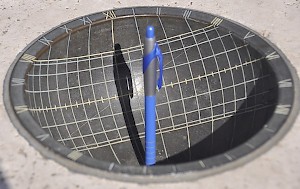
A.o. the sky, signs of the zodiac, the four elements, sun, the search for god, fortune, the power of the gods, the planets, eclipses of moon and sun, an eulogy of the first scientists, estimates of the distances between planets, comets, comets as portents, the astronomer Hipparchus of Nicaea, meteors, St Elmo's fire, the weather, the eight main winds, whirlwinds, thunder, lightning and its effects, miraculous celestial happenings, rainbows, mother earth, the spherical shape of the earth, oceans, the circumnavigation of the world, sunrise and sunset, the sun's altitude, the hours of daylight, sundials, climate and race, earthquakes, historical earthquakes, fire, petroleum, naphtha, volcanoes, the circumference of the earth.
Book 3: Geography of western and southern Europe
A.o. the Pillars of Hercules, Hispania, the measurement of distances, Italy, the Tiber, Campania and the bay of Naples, Rome, Sicily.
Book 4: Geography of eastern and northern Europe
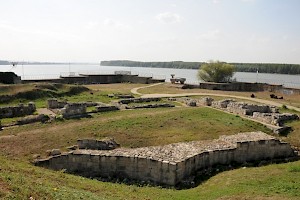
A.o., Greece, the Peloponnese, the Black Sea, the Danube, Scythia, Germania, Britain.
Book 5: Geography of northern Africa and western Asia
A.o., Africa, the Atlas, the exploration of Africa (including Hanno), Cyrenaica, the interior of Africa, Egypt, the Nile, Syria, Judaea, the Dead Sea, the Essenes, Palmyra, Asia Minor, Cyprus.
Book 6: Geography of the far south and the far east
A.o., the Black Sea, Ecbatana, the Caspian Sea, Scythia and China, size of India, rivers of India, the Indus, Sri Lanka, way of life on Sri Lanka, Babylonia, Arabia, the canal between the Nile and the Red Sea, Ethiopia.
Book 7: Anthropology and human physiology

A.o., man as the highest species in the order of creation, racial and individual characteristics, the evil eye, fire-walking, the marvels of India and Ethiopia, Pygmies, longevity among the Indians, changes of sex, pregnancy and birth, characteristics that can be transmitted, children, unusual attributes, examples of strength, sight, voice and memory, Julius Caesar, Pompey the Great, outstanding achievements, exceptional intelligent Romans, outstanding scientists and artists, happiness, Augustus, the shortness of life, signs of impending death, the soul, revival of people pronounced dead, sudden death, cremation, belief in an after-life, the discovery of arts and science, technological progress, sundials, clepsydrae.
Book 8: Land animals
A.o., elephants, the games of Pompey, snakes, Aristotle as a zoologist, lions, dromedaries and camels, giraffes, the legendary manticore, basilisk, werewolf, crocodiles, hippopotamus, hedgehogs, dogs, the dog and horse of Alexander the Great, horses, bullfights, holy cows, sheep, wool, embroidery and dyeing woolen cloth, apes.
Book 9: Marine animals

A.o., tritons, dolphins, tunny fish, lampreys, cuttlefish, squid, octopuses, crabs, the decay of morality is caused by the produce of the sea, pearls, the pearls of Cleopatra, purple fish, murex, the use of purple robes, the manufacture of purple dye, sponges, sponge diving, oysters.
Book 10: Birds
A.o., the ostrich, eagle, the eagle as standard of the legion, cocks, geese, swallows, nightingales, talking birds, carrier pigeons, parrots, parakeets, magpies, ravens, aviaries, animal reproduction, the five senses.
Book 11: Insects
A.o., bees, hives, the sources of honey, the organization of bees, honeycombs, drones, queen bees, portents provided by bees, bee-stings, the silk-moth, silk production, comparative zoology, and taxonomy: eyes, heart, anthropoid apes, bad breath of animals.
Book 12 and 13: Exotic trees

A.o., trees and their products, banyan, pepper, ginger-trees, cane-sugar, cotton-tree, resins, frankincense, myrrh, cinnamon, cassia, balsam, perfumes, palm-trees, figs, papyrus, paper, varieties of paper, history of paper, citrus-wood, aquatic trees.
Book 14: The vine
A.o., Italian trees, the decay of science and the spread of avarice, the vine, viticulture, varieties of vines and wines, Cato in viticulture, successful vineyards, famous wines, physiological effects of wine, Italian wines, foreign wines, regulations relating to wine, retsina, storage of wine, over-indulgence, famous drinkers, beer.
Book 15: Olive and other fruit trees
A.o., history of the olive-tree and the production of oil, mistaken ideas about the olive tree, uses of oil, Cato's instructions for olive growing, artificial oil, apples, pears, grafts, storage of fruit, figs, stories about figs, cherry-trees, myrtle.
Book 16: Forest trees and botany
A.o., the Chauci, military decorations, the Rostra, the award of wreaths, acorns, cork-tree, pitch-pine, ivy, aquatic shrubs and reeds, bamboo, rushes, structure of trees, large trees, wood-borers, veneers, mistletoe.
Book 17: Other useful plants
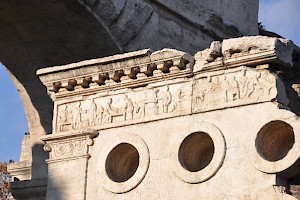
A.o., early farming, treatises on agriculture, Cato on buying a farm, farmhouses, choosing a manager, secrets of good farming, grain, pulses, wheat, barley, porridge, milling, bread, bakers at Rome, harvesting corn, the storage of grain.
Book 18: How to run a farm
Book 19: Horticulture
A.o., sailing, including a section on flax.
Book 20: Drugs obtained from garden plants
A.o., man's food and plants, cucumbers, onions, garlic, lettuce, cabbage, pennyroyal, poppies, opium.
Book 21 and 22: Drugs obtained from flowers and herbs
A.o., thyme, bees and honey, helenium, Greek weights and measures.
Book 23: Drugs obtained from the vine and the walnut
A.o., power of vinegar, walnuts.
Book 24: Drugs obtained from forest trees
A.o., trees and remedies obtained from them, medicine, remedies from trees and plants, cork-trees, juniper-trees, tree-moss, resin, ivy, holly and brambles, magical plants.
Book 25: Drugs obtained from herbs
A.o., plants used in medicine, Mithridates's interest in medicine, Greek writers in herbal medicine, moly, mandrake, hemlock, erigeron and toothache.
Book 26: Diseases and remedies
A.o., new skin diseases, leprosy, ancient medicine, Asclepiades.
Book 27: Drugs obtained from wild plants

In a more or less alphabetic order: a.o., aconite, wormwood, and the potency of drugs.
Book 28: Medicines obtained from man
A.o., remedies obtained from man himself, discussion of language, the power of charms, incantations, superstitions, human saliva, will-power, sexual intercourse, remedies from elephants and lions, milk and butter, fat, suet, marrow, gall, blood, poisons, dandruff, baldness, beauty treatment, soporifics, aphrodisiacs.
Book 29: Medicines obtained from land animals
A.o., history of the medical profession (a.k.a. as "a long stiff diatribe against doctors"), Hippocrates of Cos, famous doctors, Cato on doctors, bizarre remedies.
Book 30: Magic
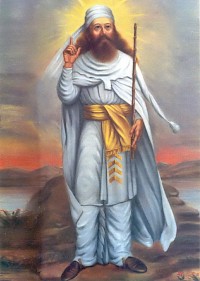
A.o., origins of magic, Zarathustra, Magians.
Book 31: Water
A.o., water, sea, water creatures, different kinds of water, poisonous waters, waters with petrifying properties, waters with beneficial properties, prospecting for water, wells, pipes, methods of carrying water, hot springs, desalination, salt, soda, sponges.
Book 32: Sea animals
A.o., forces of nature, goby, sting-ray, Ovid on fishing, coral, tortoise, oysters, medical uses of oysters, leeches.
Book 33: Gold, silver and mercury
A.o., man's greed and exploitation of the earth's resources, gold at Rome, weapons, history of the equestrian order, history of coinage, greed and its effect on Roman character, physical properties of gold, its popularity, sources of gold, mining techniques, gold produced from orpiment, gold statues, refining, silver, mercury, medical use of metals, cinnabar, touchstone, mirrors, digression on wealth, changing prices.
Book 34: Metal
A.o., history of bronze working, bronze statues, Greek and Roman styles of sculpture, famous statues, colossi, the Colossus of Rhodes, famous Greek sculptors, copper, copper slag and copper compounds used in medicine, iron-ores and smelting, lode-stone, lead, tin, medical use of lead.
Book 35: Earth
A.o., portraiture, paint and a history of painting, the painter's palette, white pigments, black pigments, eminent artists, Apollodorus, Zeuxis, Parrhasius, Apelles, Aristides, Protogenes, Italian painters, women painters, modeling, use of clay, brick-making, sulphur, bitumen, alum, kaolin and chalk.
Book 36: Stone

A.o., marble, marble statues, sculptors, Phidias, Praxiteles, Scopas, the Mausoleum at Halicarnassus, the Laocoon group, the Nile group, veined marbles, marble veneers, marble dressing, granite, obelisks, obelisks at Rome, an obelisk used as gnomon, the pyramids and the sphinx of Giza, the lighthouse of Alexandria, labyrinths, the temple of Artemis at Ephesus, the buildings of Rome, sewers, houses, Nero's Golden House, Scaurus' theater, aqueducts, water supply, magnetite, asbestos, haematite, selenite, onyx, mosaics, glass. A paean to fire and an utterly peculiar story in the very last paragraph.
Book 37: Precious stones
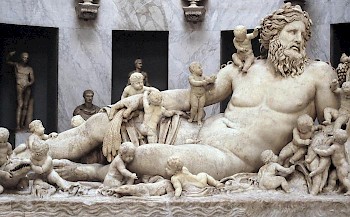
A.o., pearls, myrrhine ware, fluorspar, rock-crystal, Greek accounts of the origin of amber, the truth about amber, gemstones, diamonds, emeralds, beryls, tourmaline, amethysts, sapphires, topaz, rainbow stone, and finally a list of "best ofs", including a praise of Italy and a survey of the world's most expensive products.
Literature
An accessible edition of the Natural History can be found in the Penguin series. The Latin text can be found here.